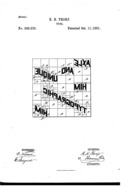Most succinctly, "unit-set" type is type made such that the set widths of all of the sorts are integral multiples of some basic unit. Of course, many systems for selecting the unit to use are possible. By way of contrast, the set widths of ordinary type need not conform to any system.
There are in theory two possible advantages for unit-set type, each of which is quite distinct from the other.
First, in the engineering of composing machines which depend on some kind of computation for line justification, the restriction to multiples of a base unit obviously greatly simplifies that computation (especially when it must be done by purely mechanical, not electronic, means). This is true both for composing machines which set pre-cast type (such as those envisioned by Wiberg and Munson, below) or those which cast type (such as the Monotype). (Aside: it is not necessary in the Linotype because the double-wedge spaceband functions as an astonishingly elegant "mechanical analog computer." Curiously, though, the Teletypesetter, designed to control a Linotype, adopted a unit-set arrangement.)
Second, in hand composition it was claimed that unit-set type allowed faster work. In particular, this claim was made by Benton for his "Self Spacing" brand of unit-set type. The cost of this increased speed was a limitation in the design of the letterforms (which had to be redesigned to fit well in the unit system) and consequent issues of aesthetics. With the advent of machine composition in the 1890s (such as the Thorne typesetter in the late 1880s (which did not use unit-set type) and more significantly the Linotype from around 1890/1892) the need for speed in hand composition disappeared.
(There is actually another kind of unit-set type which had advantages for a different purpose: the two-dimension layout, in hand-set type, of curved text. So far as I can discover, this more complex system was unique to Thorp's patent (see below).)
Unit-set type is a minor footnote in 19th century typemaking. It was only produced in any quantity by Benton, Waldo & Co. (under the now somewhat confusing trade-name "Self Spacing" type). Benton in turn was preceded by at least three others. In the 20th century, however, with the advent of tape-controlled typesetting it returned as an integral part of first the Monotype and later the Teletypesetter. Curiously, one of Benton's predecessors in the 19th century, Munson, patented a tape-controlled, unit-set typesetter before the advent of Lanston's Monotype.
The practical modern type maker probably ought to know what unit-set type is, but its application to 21st century typemaking is less clear. There is little demand now for type for hand composition adapted to speed composition at the expense of aesthetics. It is unlikely that anyone now will be developing new types for the Teletypesetter. There is, however, a need to understand type unit-set type system of the Monotype.
At first, unit-set type and point-set type (q.v.) seem nearly the same. One might think that point-set type is just unit-set type using points as the basic unit. But this is wrong, and misunderstands the theory of unit-set type.
In unit-set type, a basic unit is first selected. Typically this unit is related to the body size. This unit is then subdivided into some reasonable number of parts (e.g., 18) and all type is cast to integral unit or simple fractional unit set widths. These units need bear no direct relationship to any point system (indeed, the first unit-set types predated the American point system).
In point-set type, there is no basic unit at all. Point-set type, for all its apparent simplicity, is an ad hoc system where type is simply cast to set widths which are of integral or simple fractional point dimensions. These point-set dimensions have no direct relationship either to each other or to any controlling unit.
It is, for example, possible to design a unit-set type system in which particular sorts are of the same number of units at various body sizes. This is not possible with point-set types.

Wiberg (1854)
The patent for Wiberg's 1854 "Self-Spacing Composer" is the earliest instance identified by Huss of unit-set type.
Henry H. Thorp was the principal of the H. H. Thorp Mfg. Co., who operated the Cleveland Type Foundry. Many of this foundry's design patents for types were filed in Thorp's name, even when it is unlikely that he was directly involved with their production. It therefore isn't certain whether this invention is Thorp's that of some unknown person in the Thorp organization.
Thorp's unit-set type system is unique among the various unit-set systems known because it works in two dimensions, not just linearly. His claim begins with a definition of "ordinary" unit-set type:
"Types made of runningwise widths that are multiples of a measure of which the runningwise width of the narrowest letter-body represents the unit..."
This is a straightforward, if slightly restrictive, definition. (It is restrictive because in a more general system the unit could be smaller than the narrowest type body.)
But then he continues with something quite unusual:
"... said widths being also regular fractions of the height of the type bodywise ..."
The purpose of Thorp's unit-set system was not speed in composition, but rather ease in setting diagonal or curved text in two dimensions. Here is the illustration of an example as given in his patent:

US Patent 248,233 (1881)
US patent 248,233, "Type." Issued 1881-10-11 to Henry H. Thorp. Filed 1881-03-07. Not assigned.
Munson's work is probably more significant for its early use of tape control than for unit-set type. See the Notebook on Munson in the Noncasting Type Composing Machines section for a more thorough look.
Munson cites Wiberg's 1854 patent and argues, therefore that the idea of unit-set type is by this time "public property."

"Unit-Made Type Bodies" (1889)
Munson, James E. "Unit-Made Type Bodies." [letter to the editor in] The Inland Printer. Vol. 6, No. 6 (March, 1889): 512-513.
By his machines of 1891, Munson had abandoned unit-set type in favor of fully computed line justification.
[This is of course the major historical case, and (naturally) it is the one I haven't finished yet. Suffice it to say for now that we don't know exactly when he started, and despite what Bullen said we have no idea why, but his foundry did publish enough of what he did to reconstruct it.]
By at least 1897, the Inland Type Foundry was advertising "Unit Set Type" (with, additionally, their "Standard Line" of uniform vertical alignment). See The Inland Printer, Vol. 20, No. ? (1897): 358.
By 1899, they were advertising "Point-Set" type. See "Explanation of the Improved Point System" within a type showing in an advertisement for "Point-Set Old Style Series / Old Style No. 12 - Cast on Standard Line" in The Inland Printer, Vol. 23, No. ? (1899): 223.
For more on this, see the The Inland Type Foundry section of the Point-Set Type Notebook.
{Huss 1973} Huss, Richard E. The Development of Printers' Mechanical Typesetting Methods, 1822-1925. (Charlottesville, VA: By the University Press of Virginia for the Bibliographical Society of the University of Virginia, 1973.)
All portions of this document not noted otherwise are Copyright © 2013-2014 by David M. MacMillan and Rollande Krandall.
Circuitous Root is a Registered Trademark of David M. MacMillan and Rollande Krandall.
This work is licensed under the Creative Commons "Attribution - ShareAlike" license. See http://creativecommons.org/licenses/by-sa/3.0/ for its terms.
Presented originally by Circuitous Root®
Select Resolution: 0 [other resolutions temporarily disabled due to lack of disk space]